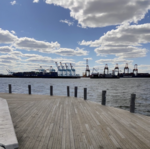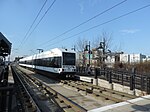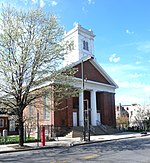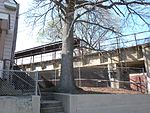8th Street station (Hudson–Bergen Light Rail)

8th Street is a station on the Hudson–Bergen Light Rail (HBLR) in the city of Bayonne, Hudson County, New Jersey. The southernmost stop in Bayonne, 8th Street station serves as the southern terminus of the Hudson–Bergen Light Rail. Located on an elevated track next to Route 440, the station is accessible at the intersection of Avenue C and West 8th Street. The station, unlike the rest of the line, has a full station depot that doubles as accessibility to tracks per the Americans with Disabilities Act of 1990. The depot is two stories high and contains elevators and access to the platform, which is an island platform with two tracks. East of the station, the tracks merge into one to reach 22nd Street station. The station serves tracks for the local service to Hoboken Terminal along with an express service known as the Bayonne Flyer. The station opened on January 31, 2011 as an extension of service from 22nd Street.The design of the 8th Street station depot is a similar design to the former West 8th Street station on the Central Railroad of New Jersey that served Bayonne from August 1, 1864–August 6, 1978, when Conrail discontinued service.
Excerpt from the Wikipedia article 8th Street station (Hudson–Bergen Light Rail) (License: CC BY-SA 3.0, Authors, Images).8th Street station (Hudson–Bergen Light Rail)
NJ 440,
Geographical coordinates (GPS) Address Nearby Places Show on map
Geographical coordinates (GPS)
| Latitude | Longitude |
|---|---|
| N 40.654 ° | E -74.127 ° |
Address
NJ 440
07002
New Jersey, United States
Open on Google Maps











